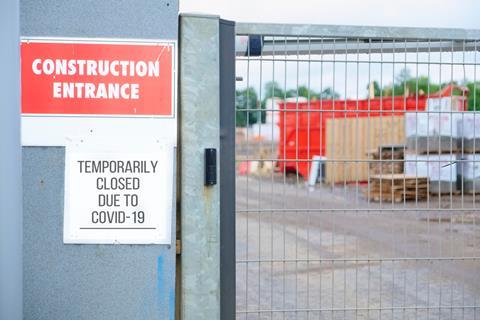Prime minister tells inquiry order to stay at home had been ‘lost’ on contractors
Rishi Sunak has claimed that more sites closed at the beginning of the covid pandemic than necessary because the construction industry had misunderstood lockdown restrictions.
The prime minister told a hearing at the Covid Inquiry that the government’s messaging on working from home had been “slightly lost” in terms of construction.
Output in the sector plunged by nearly 30% in the three months to May 2020 as sites across the country were shuttered in response to the first covid lockdown, the sharpest drop on record.

The announcement on 23 March 2020 by then prime minister Boris Johnson that people should only travel to work if absolutely necessary was met with confusion because of a lack of clarity over whether the order applied to construction sites.
Robert Jenrick, the secretary of state for housing at the time, had stepped in the next day to explain that sites should stay open.
Speaking at an inquiry hearing this week, Sunak said he did not think there was “anything that [the government] could do” to prevent its communications from being misunderstood.
The prime minister had also said in his witness statement that the Treasury had been concerned that there had been “over-compliance” with the government’s ‘stay at home’ messaging during the first lockdown.
>>> : Reporting in March 2020: Mace boss describes confusion over decision to close building sites
The inquiry’s chief lawyer Hugo Keith KC asked the prime minister: “Essentially you were concerned and your department was concerned that the public hadn’t understood sufficiently clearly from the government’s communications that they should go to work only if they could not work from home, and that the messaging perhaps had - the nuance of that position had been lost in the overall messaging “Stay at home to help us save lives”.
“What did the Exchequer do about that? Was there any means open to you to try to change the messaging or to try to ensure that people did go to work where they permissibly and legally could do so?”
Sunak replied: “You’re right in summarising the situation. Perhaps the best example of it is in the construction industry, which, because it was by its nature outdoors, and we’d seen what had happened in other European countries, more activity was able to be continued in Europe than was the case in the UK.
“I would say that was a good example of the messaging being slightly lost. I don’t think there was anything that we could do about it particularly.”
He said the confusion over sites was taken into account when drawing up an ‘exit roadmap’ from lockdown restrictions in May 2020 to ensure the messaging was clearer.
He added that the scientific advice had been predicated on assumptions on the amount of people working at home, which had been “essentially undershot and fewer people were out at work than had been anticipated.”
One contractor, who asked not to be named, said: “[What] an absolute disgrace. All those people furloughed and made redundant, plus losses of income and pay cuts.”
On 24 March 2020, Johnson overruled Sadiq Khan after the London mayor had asked for all construction sites in the capital to close unless workers were required on site for safety reasons. On the same day the CLC issued guidance to firms with a set of site operating procedures, which were revised and updated at various points through the lockdown periods.
The industry’s recovery began in May 2020, with the housing sector seeing a particularly rapid rebound with work returning by up to 42%.
Construction also found itself in the spotlight during the third covid lockdown – imposed just before Christmas 2020 – with industry leaders told the following month that the government would shut down sites in London amid concerns over the numbers of workers using public transport.
An emergency summit on the issue was held with around 40 chief executives of London’s biggest contractors along with officials from the business department and representatives from London Underground working out how to cut the number of builders using the network.
Concerns raised by the government about Tube overcrowding prompted the then Construction Leadership Council co-chair Andy Mitchell to send out an email in January 2021, warning firms of the “very real risk” of ministers imposing restrictions if the situation did not improve.



























1 Readers' comment